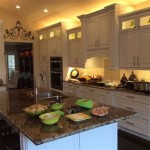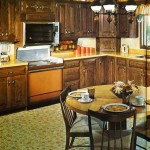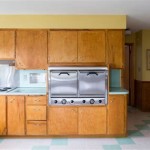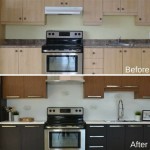Kitchen Cabinets Stain Colors: A Comprehensive Guide
The selection of stain colors for kitchen cabinets is a crucial decision in kitchen design, significantly impacting the overall aesthetic and ambience of the space. Stain, unlike paint, allows the natural grain and texture of the wood to remain visible, adding depth and warmth to the cabinetry. Understanding the various stain options, their characteristics, and how they interact with different wood types is essential for achieving the desired look.
This guide provides a detailed overview of kitchen cabinet stain colors, exploring the factors to consider when making a selection, examining popular color families, and offering insights into achieving a cohesive and visually appealing kitchen design.
Factors Influencing Stain Color Selection
Several factors should be considered when selecting the ideal stain color for kitchen cabinets. Ignoring these elements can lead to unsatisfactory results and potential design inconsistencies.
Wood Species: The type of wood used for the cabinets is a primary determinant of how the stain will appear. Different wood species possess varying grain patterns, densities, and inherent colors that interact uniquely with stains. For instance, oak has a prominent, open grain that readily absorbs stain, resulting in a more pronounced grain pattern. Maple, on the other hand, has a tighter grain, leading to a smoother, more uniform stain application.
Cherry wood is known for its natural reddish hue, which deepens over time with exposure to light. Staining cherry requires careful consideration to avoid overpowering its inherent warmth. Pine, being a softer wood, can absorb stain unevenly, often requiring pre-stain conditioners to ensure a consistent finish. Understanding the characteristics of the chosen wood species is crucial for predicting how it will react to different stain colors.
Existing Décor and Style: The stain color should complement the existing décor and overall style of the kitchen. Consider the color of the flooring, countertops, backsplash, and appliances. For example, if the kitchen features cool-toned granite countertops and stainless-steel appliances, a cooler-toned stain, such as a gray or weathered finish, might be a suitable choice.
For a more traditional kitchen with warm-toned elements, a warmer stain, such as a rich brown or cherry hue, could be more appropriate. The architectural style of the house should also be considered. A modern kitchen might benefit from a minimalist, light-colored stain, while a rustic kitchen could embrace a darker, more textured stain.
Lighting Conditions: The amount of natural and artificial light in the kitchen significantly affects how the stain color is perceived. In a kitchen with abundant natural light, a darker stain may appear less intense, while a lighter stain can be washed out. Conversely, in a kitchen with limited natural light, a lighter stain can help brighten the space, while a darker stain may make it feel smaller and more enclosed.
It is advisable to test stain samples in the actual kitchen environment under various lighting conditions to accurately assess their appearance. Consider the color temperature of the light bulbs as well. Warm-toned light bulbs can enhance the warmth of a stain, while cool-toned light bulbs can give it a more neutral appearance.
Personal Preference: Ultimately, the choice of stain color should reflect personal preferences and the desired overall atmosphere of the kitchen. Consider the feeling that the color evokes – is it warm and inviting, modern and sleek, or rustic and charming? Gather inspiration from various sources, such as design magazines, online platforms, and model homes, to identify stain colors that resonate with individual tastes.
Popular Stain Color Families for Kitchen Cabinets
Kitchen cabinet stain colors can be broadly categorized into several families, each offering a distinct aesthetic and design impact.
Light Stains: Light stains, such as natural, honey, and whitewashed finishes, are ideal for creating a bright and airy kitchen atmosphere. These stains allow the natural beauty of the wood grain to shine through, making them a popular choice for modern and minimalist kitchens. Natural stains provide a subtle, transparent layer of protection without significantly altering the wood's original color.
Honey stains add a touch of warmth and golden tones, creating a welcoming and inviting atmosphere. Whitewashed stains, also known as limewashed stains, give the cabinets a weathered, vintage look, perfect for farmhouse and cottage-style kitchens. Light stains are particularly effective in smaller kitchens, as they help to reflect light and create a sense of spaciousness.
Medium Stains: Medium stains, including shades of brown, maple, and cherry, offer a versatile and timeless appeal. These stains provide a balance between warmth and sophistication, making them suitable for a wide range of kitchen styles. Medium brown stains are classic and neutral, complementing both traditional and contemporary designs.
Maple stains enhance the wood's natural warmth, creating a cozy and inviting atmosphere. Cherry stains, with their rich reddish hues, add a touch of elegance and luxury to the kitchen. Medium stains are particularly effective at showcasing the wood grain and adding depth and character to the cabinetry.
Dark Stains: Dark stains, such as espresso, mahogany, and black, create a dramatic and sophisticated look in the kitchen. These stains add depth and richness to the cabinetry, making them a popular choice for contemporary and upscale designs. Espresso stains offer a deep, dark brown hue with subtle hints of black, creating a bold and modern statement.
Mahogany stains, with their reddish-brown tones, add a touch of warmth and luxury to the space. Black stains, when applied correctly, can create a sleek and minimalist aesthetic. Dark stains are best suited for larger kitchens with ample natural light, as they can make smaller kitchens feel more enclosed.
Gray Stains: Gray stains have gained popularity in recent years, offering a modern and versatile alternative to traditional wood stains. Gray stains provide a neutral backdrop that complements a wide range of color palettes and design styles. Light gray stains create a soft and airy feel, while darker gray stains add a touch of sophistication and drama.
Gray stains can be combined with other colors, such as white or black, to create a contemporary and minimalist kitchen. They are also effective at showcasing the texture and grain of the wood, adding depth and character to the cabinetry. Gray stains are a particularly good choice for kitchens with cool-toned countertops and stainless-steel appliances.
Achieving a Cohesive Kitchen Design with Stain Colors
Selecting the right stain color is only one aspect of creating a cohesive and visually appealing kitchen design. Careful consideration should be given to the interplay of colors, textures, and materials to achieve a harmonious overall aesthetic.
Color Harmony: The stain color should harmonize with the other elements in the kitchen, such as the flooring, countertops, backsplash, and appliances. Consider the color palette of the space and choose a stain color that complements the existing hues. A color wheel can be a useful tool for identifying complementary colors.
For example, if the kitchen features warm-toned granite countertops, a warm-toned stain, such as a cherry or honey finish, would be a suitable choice. If the kitchen features cool-toned countertops, a cooler-toned stain, such as a gray or weathered finish, would be more appropriate. Avoid selecting a stain color that clashes with the other colors in the kitchen, as this can create a jarring and unappealing effect.
Contrast and Balance: Utilize contrast to create visual interest and balance in the kitchen. For example, if the cabinets are stained a dark color, consider using a light-colored countertop to create contrast. Conversely, if the cabinets are stained a light color, a darker countertop can add visual depth. The use of contrasting hardware, such as brushed nickel or black pulls, can also enhance the overall design.
Balance the different elements in the kitchen to create a sense of harmony. Avoid overwhelming the space with too many dark colors or too many light colors. Strive for a balance between warm and cool tones to create a visually appealing and inviting atmosphere.
Texture and Material: The texture and material of the cabinets, countertops, backsplash, and flooring should also be considered when selecting a stain color. Different textures and materials can interact differently with light, affecting how the stain color is perceived.
For example, a rough-hewn wood cabinet with a dark stain can create a rustic and textured look, while a smooth, high-gloss cabinet with a light stain can create a modern and sleek aesthetic. Consider the overall feel that one is trying to achieve and choose materials and textures that complement the stain color.
Professional Consultation: Consulting with a professional kitchen designer or interior designer can be invaluable in selecting the right stain color for cabinets. A professional can provide expert guidance, taking into account the specific characteristics of the kitchen, the individual’s personal preferences, and the latest design trends.
They can also help in coordinating the various elements of the kitchen to create a cohesive and visually appealing space. Investing in professional consultation can ensure that the kitchens are both aesthetically pleasing and functional.

The New Cabinet Stain Colour For Kitchens Trends Wood

23 Best Cabinet Stain Colors Ideas Kitchen Design Grey Cabinets Home Kitchens

3 Kitchen Cabinet Stain Colors Popular In Montgomery County Pa Dailey Manufacturing Co

Cabinet Stain Colors Staining Cabinets Wood

Home Bunch S Top 5 Kitchen Design Ideas Interior

Popular Wood Stain Colors From Brighton Cabinetry Kitchen Design Partner

Woods Stain Colors Kitchen Cabinets Buffalo Ny Kreative Kitchens Baths

Stained Cabinet Color Change N Hance Wood Refinishing Of Chicago

8 Breathtaking Stain Colours For Kitchen Cabinets

How To Make Rustic Kitchen Cabinets By Refinishing Them The Best Stain Color Amanda Katherine
Related Posts








